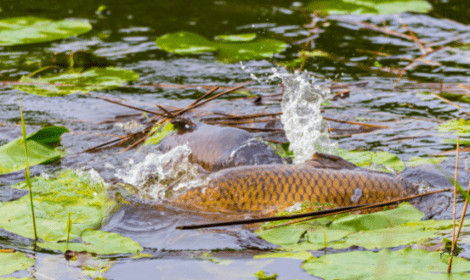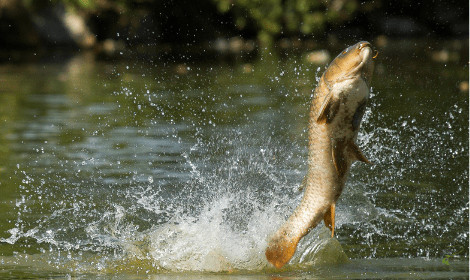
Carp are known as what is called bottom feeders. Their anatomy is set up with a downturned mouth, downward facing barbels for tasting foodstuffs below them, allowing them to cruise the bottom and taste items to dictate if they are edible.
Due to this, they spend large portions of their time cruising along the bottom, looking for anything edible.
Although carp are classed as bottom feeders, they only spend around 40-50% of their time in this area and can be found swimming in the upper layers of the water or even on the surface.
Some certain conditions and scenarios mean you will commonly see carp swimming on the surface of the water, and as an angler, I’m sure you’ve been wondering why they are swimming there and how you can catch some of these cruising carp.
In this post, I’m going to focus on why carp come to the surface to build up a detailed picture of why they are swimming on the surface and how you can have a chance of catching them.
Why Do Carp Swim on the Surface?
Turning up to a fishing venue and spotting plenty of carp on the surface can help build confidence. If you can see them, they should be easy to catch, right?
Sometimes, that’s not always the case.
Carp swim on the surface for various reasons and by knowing they do, you can tailor your fishing approach to what you see.
Weather Conditions
When the conditions are right, carp will move to the top layers of water where the water is warmest and will cruise around under the sun.
You will most likely find carp swimming on the surface on high-pressure days.
During the winter, when water temperatures have dropped significantly, the carp will go into a state of low energy expenditure where they feed far less and tend to group up in areas they feel most comfortable.
However, during periods of milder weather and sunny days in winter when the water temperature in the shallows increases slightly, they can often be found here swimming on the surface to take advantage of the slightly increased temperatures.
During these days in winter, you may have a chance of catching some of these fish with surface fishing tactics.
Spawning
Carp go through a reproduction cycle called spawning, where they will move to shallow areas of the venue, no more than around 2-3 feet.
The male carp will swim side by side with the female, where they nudge the female with their head and pectoral fins to encourage the female to release eggs.
The males fertilise these eggs with “breeding nodules” that develop just before spawning.
These spawning periods happen when the water has warmed significantly into summer, the amount of oxygen has risen in the water, and there are longer days and more daylight.
During these periods, there will be a lot of activity on the water, with the carp splashing on the surface and in the shallows as they breed.
Unfortunately, you will have no chance of catching these spawning fish as they are completely focused on breeding.
Why are Carp Jumping?
Although carp will spend time swimming on the surface when conditions are right, there may be times when you arrive at a venue to spot some carp jumping and leaving the water.
There are five types of jumps that anglers believe indicate different behaviours.
By knowing what each is and how to differentiate each, you can tailor your fishing approach to what you see in front of you.
Anatomical
The main reason you may see carp jumping and leaving the after is to do with how they change depth in deeper waters and, unfortunately, won’t give you any telltale sign of how you can catch these fish.
Carp use their swim bladders to control buoyancy and what depth they maintain under the water.
When they are seen jumping, they are forcing air throw their gills. Air can be forced in or out of their swim bladder to change depths.
They can also expel air and change depths without jumping from the water.
In shallower venues, the chances of seeing the fish jump, for this reason, are reduced significantly as far less pressure is built up with changes of depth.
Now onto the more exciting part of how some of the ways that carp jump and splash can indicate feeding behaviours.
Cleaning Method
Another reason that seems to hold is carp leap out of the water to clean debris from their gills.
As you all know, or at least should, carp are mainly bottom feeders and suck up food from the water bed. Of course, as the carp suck in food, particles of dirt and debris can also be taken in and build up in their gills.
So why not clean this debris with a leap out of the water? When the carp hit, the water rushes through their gills, washing out any built-up silt or mud.
In silty lakes, carp will rummage through the lake bed looking for food, so once again, build-ups of silt occur in their gills, so a jump from the water cleans them out.
Carp tend to find themselves bothered by parasites, so it is commonly thought that carp jump from the water as a way of ridding themselves from these parasites.
The force of the carp hitting the water is a method of scrubbing parasites from their bodies.
Crashing

Crashing refers to carp completely leaving the water and landing with a splash, similar to the video above.
The most commonly thought reason carp do this is as a cleaning method I explained above.
If the fish are feeding over a silty-bottomed area, this can indicate that the carp are feeding below. Especially if you see more than one acting in this manner.
If you spot this, it can be beneficial to get a bottom bait cast into these fish as soon as possible to see if they are interested in taking any bait and feeding.
Rolling
As you’d expect, rolling refers to the fish rolling on the surface and not leaving it as much as they do when “crashing”.
You are more likely to see this on larger bodies of water if the carp are grouped up and moving between areas of the lake.
Usually, this won’t indicate any feeding behaviour, and you will be quite unlikely to manage to get a rig to these fish and get one in the net.
Head and Shouldering
This refers to when the carp poke their head and shoulders above the water.
This is also considered a cleaning method similar to crashing when they try to rid their gills of debris after bottom feeding on silty areas.
Cast a bait to them when you see these signs, and you may find they are feeding on the bottom.
Head Poking
As you can imagine, this is where the carp poke their heads from the water. This is almost always thought to be a sign of where carp are feeding as they come to the surface to rid their gills of silt before plunging back to the depths to eat some more.
If you spot this on the water, get a bait in there as soon as possible, and your chances of catching it can greatly increase.
Make sure to cast beyond the feeding fish and then reel into the area to avoid spooking them, ruining all your increased chances.
Carp are also known to stick with habits so remember this area of the water for your next sessions to give yourself an extra edge over the fish
How to Catch Surface Carp?
If you turn up to a venue and spot plenty of carp swimming on the surface, there are a few ways in which you can target them to hopefully put a few in the net.
Throwing out a bottom rig such as a feeder rig can be counterintuitive on days like this. That being said, even though some of the carp are swimming on the surface, that’s not to say none are feeding on the bottom.
The best way to target carp on the surface is through stalking.
Stalking is a fairly easy carp tactic; you don’t need any fancy rigs tied up. In fact, a straight line hook and a piece of bread may just be enough to put fish in the net.
Stalking carp involves travelling light and travelling around a venue looking for any carp swimming or feeding on the surface.
Once you find some, you must attach a piece of bread (or other floating bait) onto your hook and cast to them.
The downside is that your rig will be extremely light with only a piece of bread and a hook attached without any substantial weight.
Due to this, it’s common to see anglers fishing for fish extremely close to the bank, swimming high in the shallow margins.
Once you spot some carp on the surface, throwing in some pieces of bread near the carp is common to encourage them to feed and watch how they react.
Not all carp swimming on the surface will be in the mood for feeding.
If the bread is enough to encourage the carp to feed, cast your hook and bread over them stealthily, and with some luck, you might entice one of the fish to suck in your bait.
It can be one of the most simple and rewarding methods of fishing for carp.
That’s All
You should now know exactly why carp swim on the surface and how you can tailor your fishing approach when this is the case.
If you have any questions, don’t hesitate to leave a reply, and I’ll get back to you ASAP.



